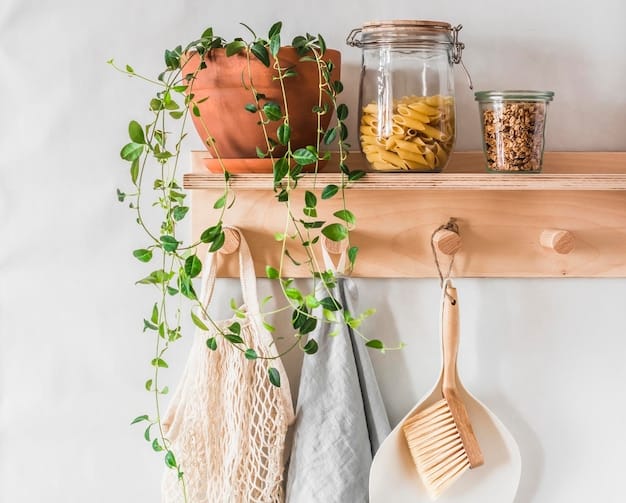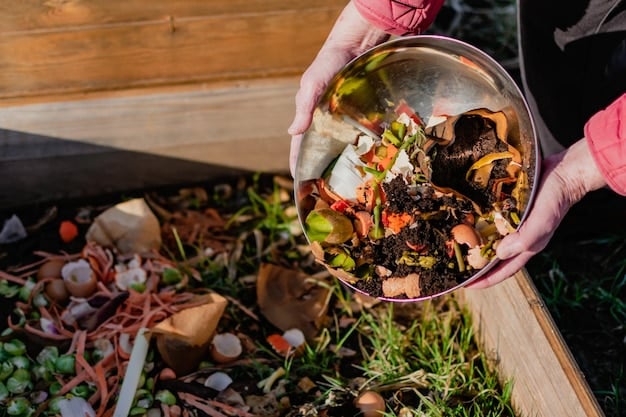Sustainable Kitchen Swaps: Save Money & Reduce Waste

Sustainable kitchen swaps offer a practical approach to reduce waste and cut household expenses by adopting eco-friendly alternatives and mindful consumption habits, aiming for a 20% reduction in both waste and spending this year.
Ready to transform your kitchen into a bastion of sustainability? Discover practical sustainable kitchen swaps that not only help the environment but also trim your household budget by up to 20% this year.
Embrace reusable alternatives
Transitioning to reusable alternatives is a cornerstone of sustainable kitchen swaps. Ditching disposable items not only reduces waste but also saves money in the long run.
Let’s delve into some easy swaps you can make today.
Swap paper towels for reusable cloths
Paper towels are a significant source of waste. Switching to reusable cloths is an easy and effective way to reduce your environmental footprint.
Use silicone baking mats instead of parchment paper
Silicone baking mats are a durable and reusable alternative to parchment paper. They’re heat-resistant, non-stick, and easy to clean.

Here are some popular reusable alternatives to consider:
- Reusable produce bags: These lightweight bags replace single-use plastic bags at the grocery store.
- Beeswax wraps: A natural and reusable alternative to plastic wrap for covering bowls and wrapping food.
- Reusable food storage containers: Opt for glass or stainless steel containers instead of plastic, which can leach chemicals into food.
By adopting these reusable alternatives, you’ll significantly reduce waste and create a more sustainable kitchen.
Composting: Turning waste into resources
Composting is an excellent way to reduce food waste and create nutrient-rich soil for your garden. By composting, you can turn kitchen scraps into valuable resources.
Here’s how to get started with composting.
Start a kitchen compost bin
A simple compost bin on your kitchen counter makes it easy to collect food scraps. These bins usually come with a lid to contain odors.
Consider different composting methods
There are various composting methods available, including traditional composting, vermicomposting (using worms), and bokashi composting (fermenting food waste).

What can you compost?
- Vegetable scraps: Carrot peels, lettuce leaves, and other vegetable trimmings are great for composting.
- Fruit scraps: Apple cores, banana peels, and other fruit waste can enrich your compost.
- Coffee grounds and tea bags: These add valuable nutrients to your compost.
Composting not only reduces landfill waste but also provides you with free, high-quality compost for your garden.
Smart grocery shopping habits
Adopting smart grocery shopping habits can help you reduce waste and save money. Planning your meals and buying only what you need are key strategies.
Here are a few tips to make the most of your grocery trips.
Plan your meals in advance
Creating a weekly meal plan helps you buy only the ingredients you need, reducing the likelihood of food waste.
Make a shopping list and stick to it
A shopping list keeps you focused and prevents impulse purchases that often lead to wasted food.
Other smart shopping habits include:
- Buy in bulk: Purchasing items in bulk can reduce packaging waste and often saves money.
- Check expiration dates: Ensure you have enough time to use the food before it expires.
- Shop at farmers’ markets: Buying local and seasonal produce supports local farmers and reduces transportation emissions.
By implementing these strategies, you can minimize waste and make your grocery shopping more sustainable.
Efficient food storage techniques
Proper food storage is crucial for keeping food fresh longer and preventing waste. Utilizing efficient storage techniques can significantly extend the life of your groceries.
Let’s explore some effective strategies.
Store produce properly
Different types of produce require different storage conditions. Some fruits and vegetables last longer in the refrigerator, while others do better at room temperature.
Use airtight containers
Airtight containers help keep food fresh by preventing exposure to air and moisture, which can cause spoilage.
Here are some additional tips for efficient food storage:
- Label and date leftovers: Knowing when leftovers were made helps you use them before they go bad.
- Rotate your stock: Keep older items at the front of your pantry and refrigerator, so you use them first.
- Freeze foods: Freezing is a great way to preserve foods that you won’t use in time, extending their shelf life significantly.
By mastering these food storage techniques, you’ll minimize waste and save money on groceries.
Reducing food waste through creative cooking
Creative cooking can transform leftover ingredients and food scraps into delicious meals. By repurposing food, you reduce waste and discover new culinary creations.
Explore these creative cooking ideas.
Make vegetable broth from scraps
Save vegetable scraps like carrot peels, onion skins, and celery ends to make a flavorful homemade broth.
Turn stale bread into croutons or breadcrumbs
Stale bread can be repurposed into crispy croutons or breadcrumbs for various dishes.
More options for creative cooking:
- Use leftover cooked vegetables in frittatas: Combine leftover veggies with eggs and cheese for a quick and easy meal.
- Transform overripe fruits into smoothies or jams: Overripe fruits are perfect for adding sweetness and flavor to smoothies or making homemade jams.
- Create a stir-fry with leftover meats and vegetables: A stir-fry is a versatile way to use up leftover meats and vegetables.
Embrace creative cooking to reduce food waste and enjoy delicious, resourceful meals.
Energy-efficient appliances and practices
Using energy-efficient appliances and adopting energy-saving practices in the kitchen can significantly reduce your carbon footprint and lower your energy bills.
Let’s look at energy efficiency in the kitchen.
Upgrade to energy-efficient appliances
When it’s time to replace your appliances, opt for energy-efficient models with the Energy Star label.
Use small appliances when possible
Small appliances like toaster ovens and slow cookers use less energy than a full-sized oven.
Other energy-saving tips include:
- Cook multiple dishes at once: If you’re using the oven, cook several dishes at the same time to maximize energy use.
- Keep your refrigerator properly maintained: Ensure the seals are tight and the temperature is set correctly to prevent energy waste.
- Unplug appliances when not in use: Many appliances continue to draw power even when turned off, so unplugging them saves energy.
By implementing these energy-efficient practices, you can create a more sustainable and cost-effective kitchen.
Water conservation in the kitchen
Conserving water in the kitchen is essential for environmental sustainability. Simple changes in your daily habits can make a significant difference.
Here’s how to conserve water effectively.
Install a low-flow faucet aerator
A low-flow faucet aerator reduces water consumption without sacrificing water pressure.
Fix leaks promptly
Even small leaks can waste a significant amount of water over time, so fix them as soon as possible.
More ways to conserve water:
- Wash dishes efficiently: Scrape food off dishes instead of rinsing them before loading them into the dishwasher.
- Use the dishwasher only when it’s full: Running a full dishwasher is more water-efficient than washing dishes by hand.
- Reuse water when possible: Use water from steaming vegetables to water your plants.
By adopting these water conservation practices, you can contribute to a more sustainable and water-wise kitchen.
| Key Point | Brief Description |
|---|---|
| ♻️ Reusable Swaps | Replace single-use items with reusable alternatives like cloths and silicone mats. |
| 🌱 Composting | Turn kitchen waste into nutrient-rich soil for your garden. |
| 🛒 Smart Shopping | Plan meals and buy only what you need to avoid wasting food and money. |
| 💧 Water Conservation | Use water efficiently with low-flow faucets and fix leaks promptly. |
Frequently Asked Questions
▼
The easiest swaps include using reusable shopping bags, replacing paper towels with cloth towels, and opting for reusable water bottles and coffee cups. These simple changes can significantly reduce waste.
▼
Plan your meals, make a shopping list, store food properly, and get creative with leftovers. Composting food scraps is another excellent way to minimize waste and enrich your garden soil.
▼
Yes, energy-efficient appliances can save you money on your utility bills in the long run. Look for the Energy Star label when purchasing new appliances to ensure they meet high energy efficiency standards.
▼
Glass and stainless steel containers are excellent choices because they are durable, non-toxic, and easy to clean. Silicone bags and beeswax wraps are also great reusable options for storing food.
▼
Scrape food off dishes before washing, use a low-flow faucet aerator, and only run the dishwasher when it’s full. Also, consider soaking dishes before washing to make them easier to clean with less water.
Conclusion
Adopting sustainable kitchen swaps can lead to significant savings and a reduced environmental impact. By embracing reusable alternatives, practicing smart shopping habits, and conserving energy and water, you can create a greener kitchen and save up to 20% on your household expenses this year.





